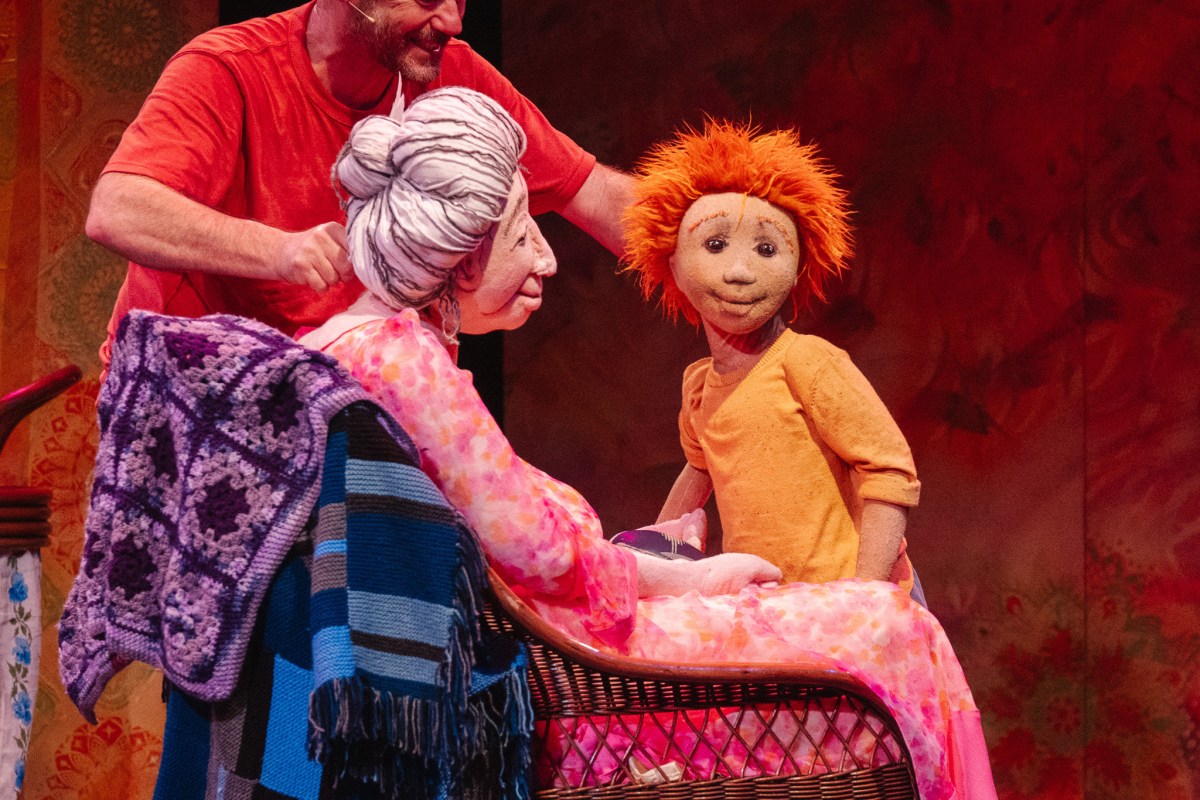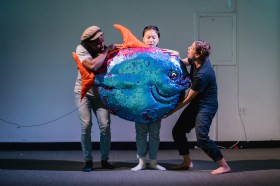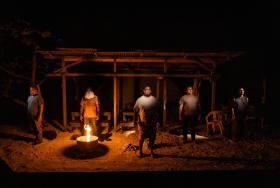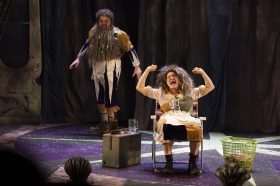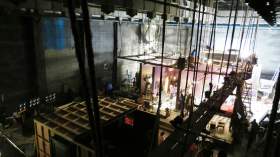The beloved 1984 children’s picture book Wilfrid Gordon McDonald Partridge by Australian author Mem Fox and illustrator Julie Vivas has been brought vividly to life by Fremantle-based Spare Parts Puppet Theatre in the Ellie Easton Theatre at Claremont Showgrounds (the company’s current base after its home venue in Fremantle was abruptly closed down by the State Government in 2022 pending essential and long-overdue repairs).
Their latest show demonstrates the company’s resilience and characteristic strengths. These include a sense of community and an ongoing artistic legacy of nurturing local puppetry and related creative skills. In this case, the show was co-created by the company’s Associate Director Michael Barlow in collaboration with long-term company performer Bec Bradley, who also directed the show and (at the performance I saw) stepped in at the last minute as a co-performer with Barlow to replace regular cast-member Tamara Creasey, who was unable to perform due to illness.
As it happens, resilience and community are the main themes of the show as well. The eponymous hero of the original book (who was playfully named by Mem Fox after her father) is a young boy who lives next door to an old people’s home where he frequently visits and is friends with the residents. His favourite is 96-year-old Miss Nancy Alison Delacourt Cooper ‘because she has four names like him’.
Miss Nancy has ‘lost her memory’, and after asking ‘what’s a memory?’ and receiving various answers Wilfrid decides to try and repair things by giving Miss Nancy a collection of objects that fit those descriptions: a box of shells (‘something from long ago’), a string-puppet (‘something that makes you laugh’), a military medal that belonged to his grandfather (‘something that makes you cry’), his own football (‘something as precious as gold’) and a freshly laid egg from the chook house (‘something warm’).
When she touches them, each of these objects evokes a tactile memory (and corresponding emotion) in Miss Nancy (a similarly form of “object therapy” is in fact a common practice in old people’s homes).
Like all good children’s stories, Wilfrid Gordon McDonald Partridge speaks to adults as well as children, and evokes tears as well as laughter. Fox has written elsewhere that the relationship between Wilfrid and Miss Nancy is based on her own relationship with her grandfather (who was also named Wilfrid, and whom she used to visit in an old people’s home in Adelaide).
She’s also written that the book was inspired by the natural rapport between children and the elderly, despite the social isolation of the latter in increasingly institutionalised and age-segregated societies like our own (and which is less prevalent in southern European and non-Western cultures).
The production takes this message of intergenerational connection and community further in terms of casting and staging. Wilfrid and Miss Nancy are large, soft, hand-held puppets, beautifully designed by Sandy McKendrick in homage to Vivas’ original watercolour illustrations and expertly manipulated by the actor-puppeteers, who also play the resident carers at the old people’s home (as well as hosting the show and addressing the audience as “visitors”); Barlow in particular is a master-puppeteer with what Keats called the ‘negative capability’ to absorb himself in the puppet and endow it with life.
The other residents, however, are played by five older audience volunteers (after a short pre-show meet-and-greet and group activity with the cast and crew) who are seated onstage and interact with the actor-puppeteers, handling props, improvising dialogue and (most importantly) touching and being touched by the puppets. These interactions provide the heart and soul of the show.
At the performance I attended, the audience volunteers were astonishingly confident and imaginative (evidently thanks in no small part to the skilful guidance of the actor-puppeteers). “Mrs Tippet” demonstrated considerable prowess with a cricket bat, “Mrs Hosking” proved to be a fluent improviser when telling a scary story and “Mr Jordan” enthusiastically mimed playing his keyboard when accompanying a group fitness class.
Melanie Robinson’s elegant cello-based score adds further liveliness as well as beauty and a hint of sadness to proceedings – especially when Wilfred and Miss Nancy dance together in the show’s closing image, framed by McKendrick’s pastel-coloured fabric set (again recalling the original illustrations) and illuminated by Lucy Birkinshaw’s warm, autumnal lighting design.
Read: Exhibition review: Demonised: Izzy Faith V, Honey Bones Gallery
In sum: Wilfrid Gordon McDonald Partridge is a show to cherish and treasure, and I hope it will have a long life with the company. Could a touring version to aged-care centres bringing younger and older audiences together be in the wings?
Wilfrid Gordon McDonald Partridge
Spare Parts Puppet Theatre
Ellie Eaton Theatre, Claremont Showground
Tickets: $28
Wilfrid Gordon McDonald Partridge will be performed until 12 April 2024.
